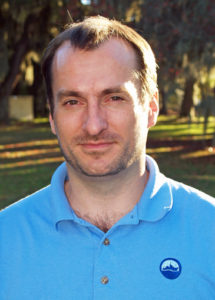Savannah, Ga. –University of Georgia Skidaway Institute of Oceanography associate professor Aron Stubbins is one of just a handful of researchers cited in the journal Limnology and Oceanography for authoring two of the journal’s top scientific papers over the past 60 years.
Limnology and Oceanography is an official publication of the Association for the Sciences of Limnology and Oceanography and is considered a premier scientific journal. In its recently published 60th anniversary issue, the journal collected and republished the 10 most cited research papers for each of the last six decades. Stubbins authored or co-authored two of those papers, one in 2008 and the other in 2010.

“It came as quite a surprise to see two articles show up on the list,” Stubbins said. “I was at a conference and wasn’t really checking my email when one of my colleagues let me know.”
The journal used the number of times a paper was cited in future studies as the yardstick to determine which papers should be included on the list. It is one commonly used method for measuring the impact of a scientist’s work.
“The list isn’t really about popularity,” Stubbins said. “It’s about usefulness. That people have found some of my work useful over the years is rewarding.”
The 2008 paper was titled “Absorption spectral slopes and slope ratios as indicators of molecular weight, source, and photobleaching of chromophoric dissolved organic matter.” The lead author was John Helms. Stubbins was a co-author along with four other scientists. The research team developed a new method for extracting new information from a relatively common and simple test of the color of dissolved organic matter.
Stubbins was the lead author, along with nine co-authors, of the second paper, “Illuminated darkness: Molecular signatures of Congo River dissolved organic matter and its photochemical alteration as revealed by ultrahigh precision mass spectrometry.” The study examined organic carbon carried to the ocean by the Congo River — after the Amazon, the second largest river in the world in terms of carbon and water flow. The research team studied how sunlight degrades organic material, including which compounds are degraded, which are not and what new compounds are created when sunlight shines on river water.
“His inclusion in this seminal volume is quite an honor for Dr. Stubbins,” UGA Skidaway Institute Interim Director Clark Alexander said. “This recognition validates what we have always known, that he is conducting groundbreaking and meaningful research that is recognized around the world.”
All 60 papers can be found at http://aslopubs.onlinelibrary.wiley.com/.


